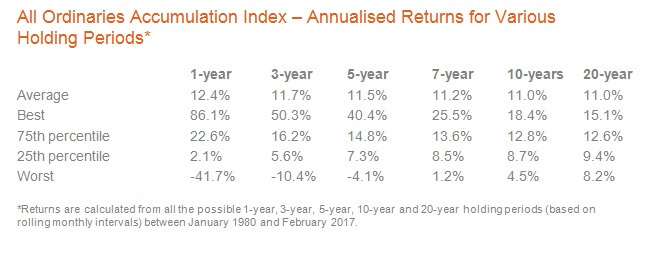Invest
How should I invest in the ASX?
Checking share prices every day may make the market seem like an unpredictable and volatile place, but take a longer view and you can begin to see exactly what equities can do for your portfolio.
How should I invest in the ASX?
Checking share prices every day may make the market seem like an unpredictable and volatile place, but take a longer view and you can begin to see exactly what equities can do for your portfolio.

We all know the equity market has its ups and downs. Bullish runs are often interrupted by sharp corrections or extended bearish periods, even amid little change in fundamentals. With so much ‘noise’, how should investors be thinking about their equity investments? I studied the historical data to try to get some answers about longer term investing in the share market. Turns out, like Mick Jagger famously said, “Time is on my side”.
One of the most obvious ways that investors try to deal with market volatility is via diversification. The idea here is that diversification helps investors reduce the volatility of their investment returns through spreading their investments across securities with less than perfect positive correlation. However, there are limits to diversification benefits, notably during particularly severe financial shocks, where returns between seemingly uncorrelated assets converge. Another way to reduce volatility in investment portfolios is to increase cash holdings, which provides a cushion against a blow to equity portfolios. The tradeoff, however, is ‘cash drag’, which undermines returns when the market is rising (which historically has been the majority of the time). Another solution is to just wait it out.
In the short-to-medium term, the broad equity market can be quite volatile but as investment horizons are lengthened, this volatility compresses as cycles are levelled out. This may be obvious, but as a recent BetaShares blog post pointed out, it’s easy to get trapped in the mindset of ‘short-termism’ or investment myopia. We know staying the course in a diversified index irons out short-term fluctuations, but it’s worth seeing just how much.
The Australian sharemarket – a case study

Since 1980, the ASX All Ordinaries Index has experienced some sharp bouts of volatility, particularly through the lens of a 12-month holding period. The worst drawdown (between November 2007 and November 2008) was -42 per cent, while the strongest rally (between July 1986 and July 1987) was +86 per cent. In addition, most observations fell between +2.1 and +22.6 per cent, suggesting not only significant dispersion, but a fairly large “tail”, or reasonably large number of years of extreme shocks. But what if our investment horizon is greater than one-year? Let’s crunch the numbers.


There are some clear conclusions we can draw from the table and chart above. As expected, the return dispersion narrows as we increase our holding period, but the degree to which it does this is really quite striking. Moving from a one-year to three-year horizon not only narrows the dispersion of return outcomes (most returns now fall between 5.6 per cent and 16.2 per cent), but significantly reduces the size of the tail and worst loss (i.e. worst loss moves from -42 per cent to -10 per cent). Moving from three-years to seven-years takes it a step further with a seven-year holding period marking the point where our worst case scenario has still generated a positive return. The benefits continue through to 10-year and 20-year holding periods, with the worst outcomes seeing positive returns of 4.5 per cent and 8.2 per cent, respectively.
So what does this all mean? When investing in equities, it’s easy for investors to get stuck in a short-sighted mindset even if our goals are long-term. However, if we acknowledge our behavioural biases and the benefits of staying the course (not to mention cost savings from reduced trading and not realising capital gains when we don’t have to), we can better align our trading strategies with our investment objectives. If we have the luxury of time and little short-term liquidity requirements, the analysis illustrates we shouldn’t be afraid of a relatively high allocation to equities – time is on your side.
Chamath De Silva, portfolio manager, BetaShares

Property
Australia’s mortgage knife‑fight: investors, first‑home buyers and the new rules of lender competition
The mortgage market is staying hot even as rate relief remains elusive, with investors and first‑home buyers chasing scarce stock and lenders fighting for share on price, speed and digital experienceRead more

Property
Breaking Australia’s three‑property ceiling: the finance‑first playbook for scalable portfolios
Most Australian investors don’t stall at three properties because they run out of ambition — they run out of borrowing capacity. The ceiling is a finance constraint disguised as an asset problem. The ...Read more

Property
Gen Z's secret weapon: Why their homebuying spree could flip Australia's housing market
A surprising share of younger Australians are preparing to buy despite affordability headwinds. One in three Gen Z Australians intend to purchase within a few years and 32 per cent say escaping rent ...Read more

Property
Tasmania’s pet-positive pivot: What landlords, BTR operators and insurers need to do now
Tasmania will soon require landlords to allow pets unless they can prove a valid reason to refuse. This is more than a tenancy tweak; it is a structural signal that the balance of power in rental ...Read more

Property
NSW underquoting crackdown: the compliance reset creating both cost and competitive edge
NSW is moving to sharply increase penalties for misleading price guides, including fines linked to agent commissions and maximum penalties up to $110,000. Behind the headlines sits a more ...Read more

Property
ANZ’s mortgage growth, profit slump: why volume without margin won’t pay the dividends
ANZ lifted home-lending volumes, yet profits fell under the weight of regulatory and restructuring costs—an object lesson in the futility of growth that doesn’t convert to margin and productivityRead more

Property
Rate pause, busy summer: where smart capital wins in Australia’s property market
With the Reserve Bank holding rates steady, the summer selling season arrives with rare predictability. Liquidity will lift, serviceability stops getting worse, and sentiment stabilises. The ...Read more

Property
The 2026 Suburb Thesis: A case study in turning trend lists into investable strategy
A new crop of ‘suburbs to watch’ is hitting headlines, but translating shortlist hype into bottom-line results requires more than a map and a mood. This case study shows how a disciplined, data-led ...Read more

Property
Australia’s mortgage knife‑fight: investors, first‑home buyers and the new rules of lender competition
The mortgage market is staying hot even as rate relief remains elusive, with investors and first‑home buyers chasing scarce stock and lenders fighting for share on price, speed and digital experienceRead more

Property
Breaking Australia’s three‑property ceiling: the finance‑first playbook for scalable portfolios
Most Australian investors don’t stall at three properties because they run out of ambition — they run out of borrowing capacity. The ceiling is a finance constraint disguised as an asset problem. The ...Read more

Property
Gen Z's secret weapon: Why their homebuying spree could flip Australia's housing market
A surprising share of younger Australians are preparing to buy despite affordability headwinds. One in three Gen Z Australians intend to purchase within a few years and 32 per cent say escaping rent ...Read more

Property
Tasmania’s pet-positive pivot: What landlords, BTR operators and insurers need to do now
Tasmania will soon require landlords to allow pets unless they can prove a valid reason to refuse. This is more than a tenancy tweak; it is a structural signal that the balance of power in rental ...Read more

Property
NSW underquoting crackdown: the compliance reset creating both cost and competitive edge
NSW is moving to sharply increase penalties for misleading price guides, including fines linked to agent commissions and maximum penalties up to $110,000. Behind the headlines sits a more ...Read more

Property
ANZ’s mortgage growth, profit slump: why volume without margin won’t pay the dividends
ANZ lifted home-lending volumes, yet profits fell under the weight of regulatory and restructuring costs—an object lesson in the futility of growth that doesn’t convert to margin and productivityRead more

Property
Rate pause, busy summer: where smart capital wins in Australia’s property market
With the Reserve Bank holding rates steady, the summer selling season arrives with rare predictability. Liquidity will lift, serviceability stops getting worse, and sentiment stabilises. The ...Read more

Property
The 2026 Suburb Thesis: A case study in turning trend lists into investable strategy
A new crop of ‘suburbs to watch’ is hitting headlines, but translating shortlist hype into bottom-line results requires more than a map and a mood. This case study shows how a disciplined, data-led ...Read more








